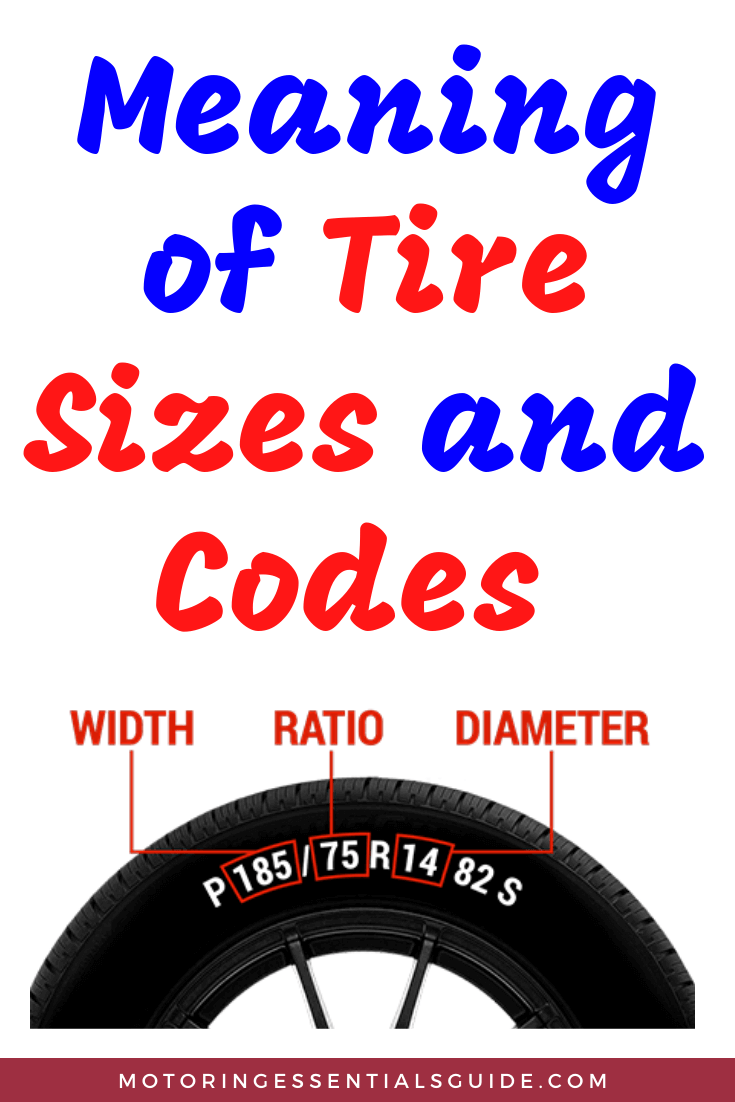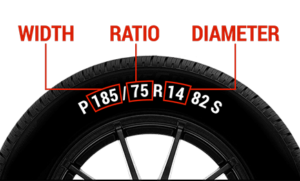Your first step in getting the right replacement tire is understanding the various letters and numbers written on the sidewall.
This article takes you through all the markings and their interpretation when it comes to tire sizing according to the ISO (international organization for standardization) metric tire code.
Walk with me.
Meaning of Tire Sizes and Codes
To make our journey easier, let’s take this hypothetical tire size code: LT225/45R17 91V M+S
(i) Letters LT (the most common alternative is P)
These simply define the type of vehicle that the tire is built for.
LT means that the tire is engineered as light pick up truck tires while P tells you that the tire is solely to be used in passenger vehicles.
I should add that you may encounter ST (for special trailers) and T (temporary usage spare wheels).
(ii) Numbers 225 (3-digit number)
This indicates the nominal width (in millimeters) of the tire measured from one sidewall to the other at the widest point.
Subsequently, our tire is 225 millimeters wide (sidewall to sidewall).
(iii) Slash character “/”
No special meaning here- its purpose is just to separate the characters.
(iv) Numbers 45 (can be 2 or 3-digit number)
Often called the series or profile, this represents the tire’s aspect ratio and is arrived at by dividing the tire’s sidewall height by its nominal section width (explained above).
Subsequently, a bigger aspect ratio translates to a bigger tire sidewall.
For clarity, our 45 “aspect ratio” means that the sidewall height is 45% of this tire’s width.
(v) Letter “R” (can be substituted with letter B or D)
Tire sizes chart also typically feature a single letter (after the “aspect ratio”) stipulating the applicable construction of the tire’s fabric carcass.
The most dominant internal construction in the market today is “R” (Radial or technically Radial-ply tire).
In this superior design, cords are laid out at 90 degrees radially (from the tire center) or perpendicular to the rotation direction resulting in a far softer ride.
Less common out there are “B” (bias belt) and “D” (diagonal) constructions because of bumpier rides.
(vi) Numbers 17 (may be a 1 or 2-digit number)
Manufacturers try to lighten the confusion for tire buyers by additionally printing what diameter wheels (in inches) their tires are supposed to fit.
Our size LT225/45R17 91V tire is hence intended for car wheels with a 17″ diameter.
Note that diameter numbers can be larger than this.
For example, some commercial transport trucks ride 22.5-inch tires.
(vii) Numbers 91 (can be 2 or 3-digit number)
This can be a 3-digit number too and stands for the standard load index for your tire (maximum weight it supports when properly inflated) so that you can have the best tire for comfort and noise.
A higher tire’s load index rating means you get more load carrying capacity.
Moving on, you’re likely to notice variations in load indices when checking tire size by vehicle.
For instance, most passenger-car tires have a load index of between 75-100 which translates varyingly to weights of 852- 1764 lbs. (refer to online tire load index charts for specifics).
Turning to light truck tires, these have two ratings on their sidewalls because these types of trucks can have dual rear wheels.
To take an example, you should interpret an index of 123/119 to mean a loading capacity of 3417 lbs. and 2998 lbs. (for two tires).
A lot of first-time buyers are confused by the reduction in combined (dual usage) load.
Well, don’t fret- it’s set to allow your vehicle to bring the load to the destination even after one tire fails.
Having said that, the most important thing is to mount tires that equals (or beats) your vehicle manufacturer’s proposed load index.
(viii) Letter “V”
The speed rating in a tire is designated by a single letter towards the end and is in this case V.
Now, this is another very specific rating- it’s the peak speed the tire safely sustains – and it’s vital that you obey it when shopping for new tires for your future safety.
The certified speed rating starts from A to Z with equivalent speeds ranging from a low of 3 mph to over 186 mph.
Each letter matches a prescribed speed and you should again checkup the relevant charts when reading a tire.
Most online sellers have these tables on their websites.
As mentioned in the case of load index, only replacement tires with at least an equal speed rating (or higher) will maintain your vehicle’s speed capability.
(ix) M+S tire size meaning
Another common tire code is the marking M+S, M.S, or even M&S.
There’s not much to worry about here as it simply identifies tires custom engineered to be champions of maneuvering mud and snow conditions and is especially common in winter tires.
These are added with winter traction-enhancing innovations such as superior siping technologies and outperform all-season (and other) tires when it’s cold because of the extra grip. Sipes improve traction and make for a smooth and quiet ride.
Likewise, the letters “M&T” (Mud and Terrain) suggests that the tire will surpass others in mud (or terrain that demands reinforced traction such as in loose gravel).
Where to find the manufacturer recommended tire size
Any debate on how to choose tire size cannot be complete without answering the question of where to find your vehicle’s original tire specifications (when coming from the factory).
Of course, it’s by far the easiest way of telling what tires will fit your car for all types of vehicles.
Here is where to locate this information:
- Placards plus certification labels permanently attached to your vehicle’s door edge, glove-box door, door post, or even inside of the car’s trunk lid.
- The owner’s manual.
The other available option (if everything else fails) is to look up the manufacturer’s number and place a call.
This can be particularly helpful since you can interrogate the staff further on questions such as the best type of tire to install on your vehicle.
Wrapping it up
Buying tires can be daunting if you haven’t figured out how to read and interpret the numerous tire codes.
This guide has shed light on how to read tire markings and we hope that your next trip to the tire shop will be much more fun.

